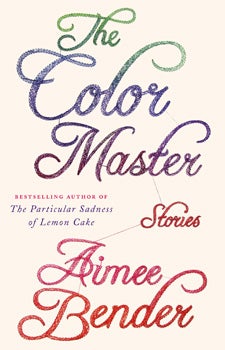The Color Master
Her favorite tale from her new book of short stories is about a woman whose ogre husband ends up devouring their children. Lucky for Aimee Bender, who gave birth to girl and boy twins in May, she writes only fiction. Read about Bender’s newest adventures . . .
L.P.: Why did you return to the format of short stories after your last novel? Do you prefer one format over the other?
A.B.: I really like doing both — I don’t necessarily decide what I’m working on, but start many projects at once and see what moves forward, like horses in a race.
L.P.: The Color Master is divided into three parts; the first section seems to have a focus on interpersonal relationships, for example, and the second seems especially character-driven. Were you exploring distinct themes, or why divide the book into parts?
A.B.: My editor did that with my first book and I liked the feel of an arc within an arc within the larger arc of the whole book — so I keep doing it. They aren’t thematically organized but I do like to arrange them like the mix tapes of yesteryear where I’d put a ballad next to a dance song and pay close attention to what started and what ended each side.
L.P.: Many of the stories are about emotional and sexual alienation, a theme you’ve written about often. What do you find so compelling about this theme? How does employing metaphor and fantasy allow you to approach a topic differently?’
A.B.: Metaphor tricks my mind into not knowing what I’m talking about, so then I seem to be able to get into it a little more deeply than I might otherwise. For me the analytical side of the brain isn’t useful for awhile in the writing process. Only very late in the game can it come in for shaping. I couldn’t say directly why I like to write about alienation so much — sometimes it surprises me still. But what drives the writing drives the writing. I consider myself lucky, with good friends and family, and yet even so I’m very familiar with loneliness and it seems to be a theme that keeps coming up again and again. And, the good feelings I have don’t usually inspire stories. Leo Tolstoy knew what he was talking about with the happy family quote — ‘All happy families are alike; each unhappy family is unhappy in its own way’ — I’d say it’s also about writing. Happy families are hard to write about!

The Color Master (Doubleday, 2013) is a collection of 15 stories Vanity Fair calls ‘richly imagined and bittersweet.’
L.P.: Do you have a favorite story in the collection?
A.B.: In this book I do — “The Devourings” is the most recent and so it’s one I’m most attached to at the moment. (In this short story an ugly woman marries an ogre and struggles with whether to stay with him after he mistakenly eats their children.)
L.P.: Where do you get your inspiration for your characters? Do they come to your mind mostly-formed or do you develop them alongside the storyline?
A.B.: They develop with the story; they kind of are the story and the two are so intertwined I can’t really separate them. Sometimes it can feel false to talk about plot and character as if they are so separate when they’re part of the same essential braid. A lot, for me, is about creating a writing space that allows me to wander around and see what I can find.
L.P.: You’re a new mom to twins! How are you enjoying motherhood? Do you think it will alter your perception as a writer?
A.B.: I’m really, really enjoying it so far, even through the fog of stress and sleep deprivation. They are very sweet babies (a girl and a boy) and I had no idea babies were so cute. Seems dumb to say, but it’s true.
L.P.: What makes up your ideal writing environment? How do the twins enter in to your writing schedule?
A.B.: Having enough time to dive in and get some work done, work that I’m not really paying attention to, work that creeps in on its own when I’m not looking and then stop. My schedule will radically change with their entrance into my life and already has but I’m not sure yet how it’ll balance. I’m intrigued though — I was ready for a change and this is a big one!